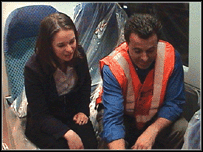The Ghost Trains of Ballymena
01 Dec 2004
The Ghost Trains of Ballymena Andy Milne talks to the men and women who work on a rail system currently under threat: Northern Ireland Railways
Jack Love is an engineer at Northern Ireland Railways’ York Road depot in Belfast. Jack’s career spans 40 years with the railway, longer than his employer has existed. Fleet Engineer, Ian Campbell, speaks highly of Jack. ‘He’s very professional.’
Jack and his colleagues need to be. NIR has had precious little investment in its short history. Line closures, speed restrictions and rolling stock that has to be cannibalised for spare parts - it’s a familiar story but curiously out dated when compared to the rest of Europe’s expanding rail industry.
Translink
Northern Ireland Railways was created out of the Ulster Transport Authority in 1968. A year later came the civil rights protests and then the long dark night of terrorism that has made the place names of Northern Ireland familiar to a generation reared on live television news.
In 1995 NIR was merged with Ulsterbus and Citybus to form Translink. The John Major administration at the time had the half baked idea of selling the whole organisation off. In fact, wiser counsel prevailed and NIR remains a vertically-integrated, state-owned railway. More intriguing still it boasts one of the lowest subsidies in Britain.
However, worse than the Major scenario is the current threat - seriously under consideration apparently - of closing the NIR network down altogether or at least truncating it outside Belfast. Nothing north of Ballymena, the gombeen men claim.
Sadly for Mr. Love and his 130 friends at York Road, the peace dividend may have come too late. Jack Love is looking forward to retirement and it looks like his employer may be facing the same option.
Put bluntly, Northern Ireland’s railway system is in poor repair. With little investment over the years, it is now considered too costly to put right by some in London. The Northern Ireland Assembly, set up by the Good Friday agreement has collapsed and transport investment is now, once again, at the mercy of bean counters in Whitehall.
Flourished
In its heyday Northern Ireland sported 900 miles of railway. Trams flourished in Belfast until the 1950s. Country trains plied across a rural heartland between Portadown and Londonderry until 1965. Express services on the Londonderry - Belfast run served stylish dinners in restaurant cars and completed the trip in 90 minutes - it now takes two and a half hours.
NIR now comprises just 210 miles - most of it single track with low linespeeds and too few passing loops. The main line south to Dublin is well maintained and double tracked. North, the line to Londonderry through Ballymena survives, as do the two lines along the north and south coasts of Belfast Lough.
Rolling stock is life expired and cannibalised out of supplies from the mainland. A Gatwick Express door hangs on a coach, new wood partitioning is worked up by Jack Love and his team mates with ceaseless ingenuity and a determination to keep the trains running. Trains are now so old that corrosion is a real problem.
It’s a great job
However, it is not all bad news, far from it. Naomi Orr is a test engineer at York Road, conducting live running tests on NIR’s new fleet of Spanish built CAF, Class 333, trains. Naomi has been with NIR two years since graduating from the University of Ulster in Belfast. ‘It’s a great job and it’s going really well,’ says Naomi.
Each train must enjoy 2,000 miles of fault free running. Part of an £80 million project, the 23 diesel three car sets - built on the same model as the Heathrow Express, were ordered by the Northern Ireland Assembly and have been arriving by sea from Bilbao since last April. Eventually the new fleet will be maintained at a purpose built depot - Fort William - near York Road, being built at a cost of £11 million.
Task Force  Ian Campbell, Fleet Engineer, NIR (pictured right), takes up the story. ‘In the year 2000 we saw commissioned a detailed report on the safety implications of under investment.’ The Arthur D. Little report made nearly 200 recommendations. ADL found that the fleet would soon not be up to delivering the existing timetable. The cost of implementing the recommendations was set at £183 million. London said the money was not available and suggested setting up a task force.
Ian Campbell, Fleet Engineer, NIR (pictured right), takes up the story. ‘In the year 2000 we saw commissioned a detailed report on the safety implications of under investment.’ The Arthur D. Little report made nearly 200 recommendations. ADL found that the fleet would soon not be up to delivering the existing timetable. The cost of implementing the recommendations was set at £183 million. London said the money was not available and suggested setting up a task force.
There are four options; Closure, Reduction (to Belfast area only), Making Good, Develop. Rattled by the word closure, the Belfast Telegraph launched a campaign, Save Our Railways, with business editor Robin Morton, taking the lead. Staff handed out leaflets and leaders from both sides of the political divide, with a consanguinity once thought rare, united in support of the railway. People in Northern Ireland do not want to lose their railway.
It was decided to equip NIR with a new train fleet. NIR went out to tender for new trains and the £80 million spend was approved by the then extant Northern Ireland Assembly. ‘We put the spec together ourselves,’ says Ian, ‘We were helped by First Procurement and Interfleet. I spent time talking to train companies in GB. All of them said make sure you get the supplier to buy into the maintenance but do the maintenance yourself.’
Spanish company, CAF, won the contract. The plan is to make good use of existing staff skills at York Road while at the same time having CAF Irlanda staff on site. ‘CAF will support us for the next 15 years. We do Planned Preventative Maintenance but if a component fails, there are staff on site - in fact we have 16 Spaniards here in Belfast already.’
 One of the CAF Irlanda staff pictured right with Naomi Orr is David Lowe who originally hails from Ireland and has been working for CAF for 11 years. As well as 23 Spanish trains, NIR is acquiring ex-Gatwick Express coaches for operation with GM locomotives.
One of the CAF Irlanda staff pictured right with Naomi Orr is David Lowe who originally hails from Ireland and has been working for CAF for 11 years. As well as 23 Spanish trains, NIR is acquiring ex-Gatwick Express coaches for operation with GM locomotives.
Atlantic Express
More good news includes the opening of the Bleach Green - Antrim line, closed in the 1970s. The Lisburn - Antrim line remains open. Bleach Green saves 30 minutes on the run to Londonderry. The £12 million project was delivered by Farrans of Dunmurry in partnership with Servirail and Carillion. The re-opened railway bridge in Belfast allows NIR to run trains direct from Londonderry, in theory, through the city and on to the main line to Dublin. In due course this would allow a Cork-Dublin-Belfast-Londonderry Atlantic Express.
Dire
However, fleet spend apart, investment remains low. Following the suspension of the Northern Ireland Assembly, control of transport spending passed back to London. As David Ford of the Alliance Party has pointed out, NIR receives a fifth as much public money as that apportioned to UK train companies. Said David, ‘For too long, public transport in Northern Ireland has been regarded as a Cinderella service. While investment in buses has been very low by UK standards, investment in our rail services is dire: less than a fifth of that given to private rail companies in GB.’
Northern Ireland Railways generates approximately £16 million income but requires £34 million a year to keep going. Passengers are subsidised at 5p per mile. In Scotland the subsidy soars to 20p a mile, in Liverpool it’s even higher at 40p per mile.
Investment is problematic for London. Faced with the Arthur D Little recommendations the man in charge, Adam Ingram MP, said the money wasn’t available and fudged the issue by setting up a task force. However, it is disingenuous to claim poverty. The £183 stipulated by ADL to re-plumb a whole network seems a snip compared to the £165 million spent on the Leeds First station and track project.
A further report from Booz Allen Hamilton, commissioned by Translink, urges a substantial increase in services. More trains would increase ridership, reduce subsidy and give better value for money. NIR, state owned and vertically integrated, is cost efficient and effectively managed. This is a railway system giving good value for money.
Reforms  Mal McGreevy, General Manager Rail Services, pictured right, has instituted a series of management reforms, ‘They give us greater clarity of responsibility and greater focus. New trains on their own won’t deliver our goal of a 60% passenger increase.’
Mal McGreevy, General Manager Rail Services, pictured right, has instituted a series of management reforms, ‘They give us greater clarity of responsibility and greater focus. New trains on their own won’t deliver our goal of a 60% passenger increase.’
NIR now has a Railway Operations Manager - responsible for drivers and signallers and the running of the service. The Customer Services Manager is responsible for passengers and looks after the ticket clerks, conductors and RPIs. Booz Allen Hamilton has picked up on the principle of high frequency, high quality railways, attracting more custom.
Proof of this is not hard to find. The ‘Enterprise’ service connecting Belfast and Dublin is operated jointly by Iarnrod Eireann and Northern Ireland Railways. Trains run every two hours on double track with line speeds of 90 mph. The service is quick, clean and efficient.
The coaches - modelled on French TGV stock - are maintained at York Road and the GM locos at Inchicore in the Republic. Since 1998 Enterprise has recorded a 60% rise in ridership. £165 million was invested in the service which now carries one million passengers per annum.
It is extensively used by Dublin-Dundalk passengers and Newry - Belfast passengers as well as a growing number of cross border tourists and business people. For Ireland the Enterprise service proves that fast, clean, modern trains attract people back to rail.
Modest
Following the Good Friday agreement and cease-fire Northern Ireland is in a rush to catch up with the other economies of Europe’s Atlantic sea board. New businesses blossom throughout the province. The green fields of Armagh are studded with housing developments.
Central Belfast is full of shops and large department stores - like any other prosperous European city of over 300,000 people. Ulster still has seemingly intractable political challenges which no one locally underestimates. However, the commercial sector seems prepared to take the risk.
If Northern Ireland is to prosper - arguably the best guarantee of long lasting peace - then it needs a modern transport infrastructure on which to do so. Few in the north will have failed to notice the money pouring into railways south of the border or the investment, all £8 billion pounds of it, being kneaded into the West Coast Main Line as well as the CTRL and the welter of spending plans announced for London.
Northern Ireland’s investment requirements seem modest by comparison. It is about time the cheque writers in London took a similar risk. How sad if the network were to close and the ghost trains of Ballymena became yet another testimony to London intransigence and treasury myopia.
